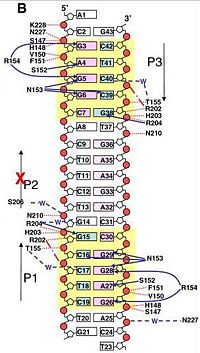Introduction
The SV40 large tumor antigen is a multifunctional regulatory protein encoded by Simian Virus 40. It is classified under the AAA+ family of helicases [1]. The protein is responsible for initiation of viral DNA replication, regulation of viral transcription and transformation of the host cell to promote viral infectivity. Large T-antigen is an early gene product of SV40 and is produced via differential mRNA splicing.
Structure and Function
T antigen is a 708-amino acid protein consisting of three major domains: an N-terminal J domain, a central origin-binding domain, and a C-terminal helicase domain [2].
(1tbd).
The Origin Binding Domain
The origin binding domain monomer consists of five anti-parallel beta sheets flanked on either side by a pair of alpha helices. The monomers assemble into a hexameric left-handed spiral, whose pitch complements the turn of DNA. Side-side interaction is necessary for hexamerization, in which residues are crucial. Residues along the are necessary in the assembly of a double hexamer. A central pore is formed, large enough for dsDNA, carrying positive charge. A monomer along this pore is able to bind along a series of GAGGC pentanucleotides P1 through P4 at the origin, collectively known as Site II. implicated in DNA binding are ; ; as well as [1]. The structural fold adopted by the fully assembled double hexamer is similarly conserved across a number of origin-binding proteins in different viruses, despite varying protein sequences, suggesting sequence-specificity. The Asn and Arg in the A1 motif primarily make up base-specific interactions with the DNA, whereas residues from the B2 loop interact mainly with the phosphate backbone. These specific interactions bury a large surface area of the protein and give rise to a 60nM Kd.[3].
Binding of large T antigen at the origin of replication allows replicative machinery to unwind and synthesize new DNA. Residues involved in DNA binding also bind ssDNA-binding protein human RPA[4]. T antigen also acts as a repressor of early gene transcription. When increased amounts of T antigen are present, it binds DNA and blocks the overlapping promoter sequence, thus behaving as its own regulator.
(stick model), Zn+2 (grey) and Mg+2 (green) ions, 1svm.
Helicase
The consists of a AAA+ domain. Each monomer binds and hydrolyzes an ATP at this region in the presence of magnesium ion. Together, the monomers drive an overall conformational change in the hexamer. The helicase monomer can exist in one of three states: ATP-bound, ADP-bound and Nt-free. The transitions in conformation between these states enable the unwinding of viral dsDNA. There are both cis- and trans-monomer interactions involving ATP.
Lys432, Thr433 and Thr434 of the P loop interact closely with the triphosphate groups, and Asp474 and Asn529 form H bonds with ATP on the same residue. Among these, Ilu428, Thr433 and Asp474 adopt different conformations in the ADP-bound state. In the Nt-free state, Ilu428 and Thr434 are turned even further and sterically disallow the presence of ADP.
near the ATP is present for stability and nucleophilic attack during hydrolysis.
, of which Lys418 and Lys419 stabilize ATP hydrolysis, interact with ATP on adjacent monomers, important in producing conformational changes.
These rearrangements affect the position of a positively-charged structure that protrudes into the central channel. Trans-residues Arg498, Asp499 and Asp502 are located at the base of the hairpin, lending a lever-like functionality. The motion of the β hairpin unwinds the DNA through the central channel [5].
The helicase domain is also implicated in binding to p53, a transcription factor vital in tumor suppression. Binding of helicase inhibits the functional tetramerization of p53 on DNA[6].
(green), 1gh6.
J domain and LxCxE motif
In the transformation of the host cell, retinoblastoma, a tumor suppressor, is inactivated via both the N-terminal J domain and the LxCxE motif. The N-terminal region (residues 7-117), shown to the right in blue, consists of and . These contain the J domain and the LxCxE motif respectively [7]. The large T antigen J domain is a functional homolog of the molecular chaperone DnaJ protein, namely HDJ-1 of E. coli[8] and human Hsp40[9]. The alpha helices α2 and α3 that form the core of the domain are stabilized by the dominant hydrophobicity of conserved residue sidechains, e.g. Leu17, Phe41, Trp95. Mutations in these residues cause disruptive perturbations. Additionally, further stabilize the core. Residues of Loop 2 are conserved across the J domain family[7] and are crucial in recognizing hsc70, a factor of Rb inactivation. However, though such similarity with homologs exists, there are structural differences. These include residues 68-78 of Loop 3, which form hydrogen bonds with the retinoblastoma pocket and stabilize the J domain internally; and 91-102 of helix α4, of which Asn96 and Glu100 form hydrogen bonds with Lys765 and Gln762 from the Rb pocket.
The The LxCxE motif is accommodated by a groove in the Rb pocket and accounts for two-thirds of the total buried surface area in the interaction. A number of occur along the loop. Furthermore, the end contains a . It is proposed that this region interacts with a cluster of lysine residues near the LxCxE binding site of Rb[10]. Kinase-mediated phosphorylation of Ser111 and Ser112 might then induce a conformational change in the loop which allows these interactions to occur more favorably.
Both large T antigen and E2F are able to complex with the Rb pocket simultaneously, suggesting their respective sites are different. So binding is not competitive. Thus to resolve the question of how large T antigen mediates E2F release from Rb, its similarity to homologs is considered. DnaJ serves not only to aid in folding proteins, but also to disassemble complexes. As such, it is proposed the large T antigen J domain may recruit hsc70, which then dissociates the EF2-Rb complex[7]. .


